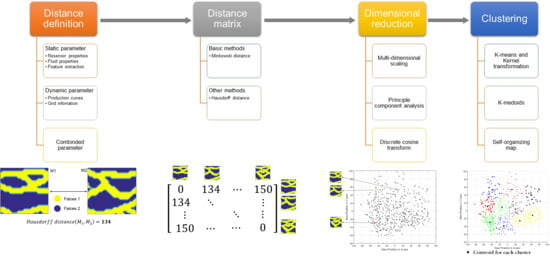Efficient Assessment of Reservoir Uncertainty Using Distance-Based Clustering: A Review
Abstract
:1. Introduction
2. Distance and Dimensional Reduction
2.1. Distance
- Static distance
- Dynamic distance
- Combined distance
2.2. Distance Matrix
2.3. Dimensional Reduction
3. Clustering Algorithms
3.1. K-means Clustering
| Algorithm 1 K-means clustering |
| SELECT points as the initial group centroids c1, c2, ⋯, ck |
| REPEAT |
| Make clusters by assigning data points to the closest centroid |
| Recalculate the centroid of each cluster by the mean of the data in the cluster |
| UNTIL the centroids do not change |
3.2. K-medoids Clustering
| Algorithm 2 K-medoids clustering |
| SELECT points as the initial group medoids , , , |
| REPEAT |
| Make clusters by assigning data points to the closest medoid |
| Calculate total distance between the medoid and non-medoid data |
| FOR each medoid DO |
| Select the non-medoid to calculate new total distance |
| IF < |
| Change to |
| END IF |
| END FOR |
| UNTIL the medoids do not change |
3.3. Self-Organizing Map
4. Applications
4.1. Unconventional Resources and Real Fields
4.2. Comparisons of a Synthetic Case
5. Conclusions
Author Contributions
Funding
Acknowledgments
Conflicts of Interest
References
- Lee, K. Channelized Reservoir Characterization using Ensemble Smoother with a Distance-Based Method. PhD Thesis, Seoul National University, Seoul, Korea, 2014. [Google Scholar]
- Lee, K.; Lim, J.; Ahn, S.; Kim, J. Feature extraction using a deep learning algorithm for uncertainty quantification of channelized reservoirs. J. Pet. Sci. Eng. 2018, 171, 1007–1022. [Google Scholar] [CrossRef]
- Lee, K.; Lim, J.; Choe, J.; Lee, H.S. Regeneration of channelized reservoirs using history-matched facies-probability map without inverse scheme. J. Pet. Sci. Eng. 2017, 149, 340–350. [Google Scholar] [CrossRef]
- Lee, J.; Choe, J. Reliable reservoir characterization and history matching using a pattern recognition based distance. In Proceedings of the ASME 2016 35th International Conference on Ocean, Offshore and Arctic Engineering, Busan, Korea, 19–24 June 2016. [Google Scholar]
- Kang, B.; Choe, J. Regeneration of initial ensembles with facies analysis for efficient history matching. J. Energy Resour-ASME 2017, 139, 042903. [Google Scholar] [CrossRef]
- Kang, B.; Choi, J.; Lee, K.; Jang, I.; Choe, J. Distance-based clustering using streamline simulations for efficient uncertainty assessment. In Proceedings of the 18th Annual Conference of IAMG, Perth, Australia, 2–9 September 2017. [Google Scholar]
- Lee, K.; Jung, S.; Lee, T.; Choe, J. Use of clustered covariance and selective measurement data in ensemble smoother for three-dimensional reservoir characterization. J. Energy Resour-ASME 2017, 139, 022905. [Google Scholar] [CrossRef]
- Lee, K.; Jeong, H.; Jung, S.; Choe, J. Characterization of channelized reservoir using ensemble Kalman filter with clustered covariance. Energy Explor. Exploit. 2013, 31, 17–29. [Google Scholar] [CrossRef]
- Lee, K.; Jung, S.; Choe, J. Ensemble smoother with clustered covariance for 3D channelized reservoirs with geological uncertainty. J. Pet. Sci. Eng. 2016, 145, 423–435. [Google Scholar] [CrossRef]
- Suzuki, S.; Caers, J. A distance-based prior model parameterization for constraining solutions of spatial inverse problems. Math. Geosci. 2008, 40, 445–469. [Google Scholar] [CrossRef]
- Suzuki, S.; Caers, J. History matching with an uncertain geological scenario. In Proceedings of the SPE Annual Technical Conference and Exhibition, San Antonio, TX, USA, 24–27 September 2006. [Google Scholar]
- Suzuki, S.; Caumon, G.; Caers, J. Dynamic data integration for structural modeling: Model screening approach using a distance-based model parameterization. Computat. Geosci. 2008, 12, 105–119. [Google Scholar] [CrossRef]
- Lee, H.; Jin, J.; Shin, H.; Choe, J. Efficient prediction of SAGD productions using static factor clustering. J. Energy Resour-ASME 2015, 137, 032907. [Google Scholar] [CrossRef]
- Sahaf, Z.; Hamdi, H.; Mota, R.C.R.; Sousa, M.C.; Maurer, F. A Visual Analytics Framework for Exploring Uncertainties in Reservoir Models. In Proceedings of the 13th International Joint Conference on Computer Vision, Madeira, Portugal, 27–29 January 2018. [Google Scholar] [CrossRef]
- Gross, H.; Honarkhah, M.; Chen, Y. Offshore Gas Condensate Field History-Match and Predictions: Ensuring Probabilistic Forecasts Are Built with Diversity in Mind. In Proceedings of the SPE Asia Pacific Oil and Gas Conference and Exhibition, Jakarta, Indonesia, 20–22 September 2011. [Google Scholar] [CrossRef]
- Patel, R.G.; Trivedi, J.; Rahim, S.; Li, Z. Initial sampling of ensemble for steam-assisted-gravity-drainage-reservoir history matching. SPE J. 2015, 54, 424–441. [Google Scholar] [CrossRef]
- Li, Q.; Aguilera, R. Unsupervised Statistical Learning with Integrated Pattern-Based Geostatistical Simulation. In Proceedings of the SPE Western Regional Meeting, Garden Grove, CA, USA, 22–26 April 2018. [Google Scholar]
- Honarkhah, M.; Caers, J. Stochastic simulation of patterns using distance-based pattern modeling. Math. Geosci. 2010, 42, 487–517. [Google Scholar] [CrossRef]
- Arpat, G.B.; Caers, J. A Multiple-scale, Pattern-based Approach to Sequential Simulation. In Quantitative Geology and Geostatistics: Proceedings of the 7th International Geostatistics Congress, Banff, AB, Canada, 2004; Springer: Dordrecht, The Netherlands, 2005; Volume 14. [Google Scholar] [CrossRef]
- Koneshloo, M.; Aryana, S.A.; Grana, D.; Pierre, J.W. A workflow for static reservoir modeling guided by seismic data in a fluvial system. Math. Geosci. 2017, 49, 995–1020. [Google Scholar] [CrossRef]
- Lee, K.; Jeong, H.; Jung, S.; Choe, J. Improvement of ensemble smoother with clustering covariance for channelized reservoirs. Energy Explor. Exploit. 2013, 31, 713–726. [Google Scholar] [CrossRef]
- Lim, J.; Jin, J.; Choe, J. Features Modeling of Oil Sands Reservoirs in Metric Space. Energy Source Part A 2014, 36, 2725–2735. [Google Scholar] [CrossRef]
- Lim, J.; Jin, J.; Lee, H.; Choe, J. Uncertainty Analysis of Oil Sands Reservoirs Using Features in Metric Space. Energy Source Part A 2015, 37, 1736–1746. [Google Scholar] [CrossRef]
- Kang, B.; Yang, H.; Lee, K.; Choe, J. Ensemble Kalman filter with principal component analysis assisted sampling for channelized reservoir characterization. J. Energy Resour-ASME 2017, 139, 032907. [Google Scholar] [CrossRef]
- Kang, B.; Choe, J. Initial model selection for efficient history matching of channel reservoirs using ensemble smoother. J. Pet. Sci. Eng. 2017, 152, 294–308. [Google Scholar] [CrossRef]
- Jung, H.; Jo, H.; Kim, S.; Lee, K.; Choe, J. Geological model sampling using PCA-assisted support vector machine for reliable channel reservoir characterization. J. Pet. Sci. Eng. 2018, 167, 396–405. [Google Scholar] [CrossRef]
- Jafarpour, B.; McLaughlin, D.B. History matching with an ensemble Kalman filter and discrete cosine parameterization. Comput. Geosci. 2008, 12, 227–244. [Google Scholar] [CrossRef]
- Jafarpour, B.; McLaughlin, D.B. Reservoir Characterization With the Discrete Cosine Transform. SPE J. 2009, 14, 181–202. [Google Scholar] [CrossRef]
- Zhao, Y.; Forouzanfar, F.; Reynolds, A.C. History matching of multi-facies channelized reservoirs using ES-MDA with common basis DCT. Comput. Geosci. 2017, 21, 1343–1364. [Google Scholar] [CrossRef]
- Kim, S.; Lee, C.; Lee, K.; Choe, J. Characterization of channel oil reservoirs with an aquifer using EnKF, DCT, and PFR. Energy Explor. Exploit. 2016, 34, 828–843. [Google Scholar] [CrossRef]
- Kim, S.; Lee, C.; Lee, K.; Choe, J. Characterization of channelized gas reservoirs using ensemble Kalman filter with application of discrete cosine transformation. Energy Explor. Exploit. 2016, 34, 319–336. [Google Scholar] [CrossRef]
- Kim, S.; Min, B.; Lee, K.; Jeong, H. Integration of an Iterative Update of Sparse Geologic Dictionaries with ES-MDA for History Matching of Channelized Reservoirs. Geofluids 2018, 2018, 1532868. [Google Scholar] [CrossRef]
- Kim, S.; Min, B.; Kwon, S.; Chu, M. History Matching of a Channelized Reservoir Using a Serial Denoising Autoencoder Integrated with ES-MDA. Geofluids 2019, 2019. [Google Scholar] [CrossRef]
- Jo, H.; Jung, H.; Ahn, J.; Lee, K.; Choe, J. History matching of channel reservoirs using ensemble Kalman filter with continuous update of channel information. Energy Explor. Exploit. 2017, 35, 3–23. [Google Scholar] [CrossRef]
- Jung, H.; Jo, H.; Kim, S.; Lee, K.; Choe, J. Recursive update of channel information for reliable history matching of channel reservoirs using EnKF with DCT. J. Pet. Sci. Eng. 2017, 154, 19–37. [Google Scholar] [CrossRef]
- Insuasty, E.; Van den Hof, P.M.; Weiland, S.; Jansen, J.D. Flow-based dissimilarity measures for reservoir models: A spatial-temporal tensor approach. Comput. Geosci. 2017, 21, 645–663. [Google Scholar] [CrossRef]
- Scheidt, C.; Caers, J. Uncertainty quantification in reservoir performance using distances and kernel methods—Application to a west africa deepwater turbidite reservoir. SPE J. 2009, 14, 680–692. [Google Scholar] [CrossRef]
- Lee, K.; Jo, G.; Choe, J. Improvement of ensemble Kalman filter for improper initial ensembles. Geosyst. Eng. 2011, 14, 79–84. [Google Scholar] [CrossRef]
- Zheng, J.; Leung, J.Y.; Sawatzky, R.P.; Alvarez, J.M. A Cluster-Based Approach for Visualizing and Quantifying the Uncertainty in the Impacts of Uncertain Shale Barrier Configurations on SAGD Production. In Proceedings of the SPE Canada Heavy Oil Technical Conference, Calgary, AB, Canada, 13–14 March 2018. [Google Scholar]
- Jin, J.; Lim, J.; Lee, H.; Choe, J. Metric space mapping of oil sands reservoirs using streamline simulation. Geosyst. Eng. 2011, 14, 109–113. [Google Scholar] [CrossRef]
- Park, K.; Caers, J. History matching in low-dimensional connectivity-vector space. In Proceedings of the EAGE Conference on Petroleum Geostatistics, Cascais, Portugal, 10–14 September 2007. [Google Scholar]
- Scheidt, C.; Caers, J. Representing Spatial Uncertainty Using Distances and Kernels. Math. Geosci. 2009, 41, 397. [Google Scholar] [CrossRef]
- Chiotoroiu, M.M.; Peisker, J.; Clemens, T.; Thiele, M.R. Forecasting Incremental Oil Production of a Polymer-Pilot Extension in the Matzen Field Including Quantitative Uncertainty Assessment. SPE Reserv. Eval. Eng. 2017, 20, 894–905. [Google Scholar] [CrossRef]
- Caers, J.; Park, K. A distance-based representation of reservoir uncertainty: The metric EnKF. In Proceedings of the ECMOR XI-11th European Conference on the Mathematics of Oil Recovery, Bergen, Norway, 8–11 September 2008. [Google Scholar]
- Srinivasan, S.; Mantilla, C. Uncertainty Quantification and Feedback Control Using a Model Selection Approach Applied to a Polymer Flooding Process. In Proceedings of the Geostatistics, Oslo, Norway, 11–15 June 2012. [Google Scholar]
- Zheng, J.; Leung, J.Y.; Sawatzky, R.P.; Alvarez, J.M. An AI-based workflow for estimating shale barrier configurations from SAGD production histories. Neural Comput. Appl. 2018. [Google Scholar] [CrossRef]
- Khojastehmehr, M.; Naderifar, A.; Aminshahidy, B. Enhanced oil recovery assignment using a new strategy for clustering oil reservoirs: Application of fuzzy logics. J. Chemometr. 2018. [Google Scholar] [CrossRef]
- Park, J.; Jin, J.; Choe, J. Uncertainty quantification using streamline based inversion and distance based clustering. J. Energy Resour-ASME 2016, 138, 012906. [Google Scholar] [CrossRef]
- Simon, E.; Samuelsen, A.; Bertino, L.; Mouysset, S. Experiences in multiyear combined state-parameter estimation with an ecosystem model of the North Altlantic and Artic Oceans using the Ensemble Kalman Filter. J. Mar. Syst. 2015, 152, 1–17. [Google Scholar] [CrossRef]
- Mouysset, S.; Noailles, J.; Ruiz, D. On An Interpretation of Spectral Clustering Via Heat Equation And Finite Elements Theory. In Proceedings of the WCE (World Congress on Engineering), London, UK, 30 June–2 July 2010. [Google Scholar]
- Lee, K.; Kim, S.; Choe, J.; Min, B.; Lee, H.S. Iterative static modeling of channelized reservoirs using history-matched facies probability data and rejection of training image. Pet. Sci. 2019, 16, 127–147. [Google Scholar] [CrossRef]
- Siena, M.; Guadagnini, A.; Della Rossa, E.; Lamberti, A.; Masserano, F.; Rotondi, M. A Novel Enhanced-Oil-Recovery Screening Approach Based on Bayesian Clustering and Principal-Component Analysis. SPE J. 2016, 19, 382–390. [Google Scholar] [CrossRef]
- Kang, B.; Jung, H.; Choi, J.; Choe, J. Improvement of Simulation Runs Using Clustering Schemes in Generalized Travel Time Inversion. In Proceedings of the 18th Annual Conference of IAMG, Perth, Australia, 2–9 September 2017. [Google Scholar]
- Chen, C.; Gao, G.; Ramirez, B.A.; Vink, J.C.; Girardi, A.M. Assisted History Matching of Channelized Models Using Pluri-Principal Component Analysis. SPE J. 2016, 21, 1793–1812. [Google Scholar] [CrossRef]
- Amirian, E.; Leung, J.Y.; Zanon, S.; Dzurman, P. Integrated cluster analysis and artificial neural network modeling for steam-assisted gravity drainage performance prediction in heterogeneous reservoirs. Expert Syst. Appl. 2015, 42, 723–740. [Google Scholar] [CrossRef]
- Canchumuni, S.A.; Emerick, A.A.; Pacheco, M.A. Integration of ensemble data assimilation and deep learning for history matching facies models. In Proceedings of the Offshore Technology Conference, Rio de Janeiro, Brazil, 24–26 October 2017. [Google Scholar]
- Jain, A.K.; Murty, M.N.; Flynn, P.J. Data clustering: A review. ACM Comput. Surv. 1999, 31, 264–323. [Google Scholar] [CrossRef]
- Rojas, T.; Demyanov, V.; Christie, M.; Arnold, D. Learning uncertainty from training images for reservoir predictions. In Mathematics of Planet Earth; Pardo-Igúzquiza, E., Guardiola-Albert, C., Heredia, J., Moreno-Merino, L., Durán, J., Vargas-Guzmán, J., Eds.; Springer: Berlin/Heidelberg, Germany, 2014; pp. 147–151. [Google Scholar]
- Velmurugan, T.; Santhanam, T. Computational complexity between K-means and K-medoids clustering algorithms for normal and uniform distributions of data points. J. Comp. Sci. 2010, 6, 363–368. [Google Scholar] [CrossRef]
- Arora, P.; Deepali; Varshney, S. Analysis of K-means and K-medoids algorithm for big data. In Proceedings of the International Conference on Information Security & Privacy, Nagpur, India, 11–12 December 2015. [Google Scholar]
- Patel, A.; Singh, P. New approach for K-mean and K-medoids algorithm. IJCAES 2013, 2, 1–5. [Google Scholar] [CrossRef]
- Shawe-Taylor, J.; Cristianini, N. Kernel Methods for Pattern Analysis; Cambridge University Press: Cambridge, UK, 2004. [Google Scholar]
- Shi, J.; Malik, J. Normalized cuts and image segmentation. IEEE Trans. Pattern Anal. Mach. Intell. 2000, 22, 888–905. [Google Scholar] [CrossRef]
- Hingerl, F.F.; Thiele, M.R.; Batycky, R.P. Reservoir Management of a Low-Salinity Flood on a Per-Pattern Basis. In Proceedings of the SPE Improved Oil Recovery Conference, Tulsa, OK, USA, 14–18 April 2018. [Google Scholar] [CrossRef]
- Kharyba, E.; Demyanov, V.; Antropov, A.; Malencic, L.; Stulov, L. Neural network classification to improve geological and engineering understanding for more reliable reservoir prediction. In Proceedings of the 19th Annual Conference of the International Association for Mathematical Geosciences, Olomouc, Czech Republic, 2–8 September 2018. [Google Scholar]
- Milligan, G.W.; Cooper, M.C. An examination of procedures for determining the number of clusters in a data set. Psychometrika 1985, 50, 159–179. [Google Scholar] [CrossRef]
- Jia, B.; Tsau, J.-S.; Barati, R. A review of the current progress of CO2 injection EOR and carbon storage in shale oil reservoirs. Fuel 2019, 236, 404–427. [Google Scholar] [CrossRef]
- Alharthy, N.; Teklu, T.W.; Kazemi, H.; Graves, R.M.; Hawthorne, S.B.; Braunberger, J.; Kurtoglu, B. Enhanced Oil Recovery in Liquid-Rich Shale Reservoirs: Laboratory to Field. SPE Reserv. Eval. Eng. 2018, 21, 137–159. [Google Scholar] [CrossRef]
- Jia, B.; Tsau, J.-S.; Barati, R. Measurement of CO2 Diffusion Coefficient in the Oil-Saturated Porous Media. In Proceedings of the Abu Dhabi International Petroleum Exhibition and Conference, Abu Dhabu, UAE, 12–15 November 2018. [Google Scholar] [CrossRef]
- Jia, B.; Tsau, J.-S.; Barati, R. Role of molecular diffusion in heterogeneous, naturally fractured shale reservoirs during CO2 huff-n-puff. J. Pet. Sci. Eng. 2018, 164, 31–42. [Google Scholar] [CrossRef]
- Fenik, D.R.; Nouri, A.; Deutsch, C.V. Criteria for ranking realizations in the investigation of SAGD reservoir performance. In Proceedings of the Canadian International Petroleum Conference, Calgary, AB, Canada, 16–18 June 2009. PETSOC-2009-191. [Google Scholar] [CrossRef]
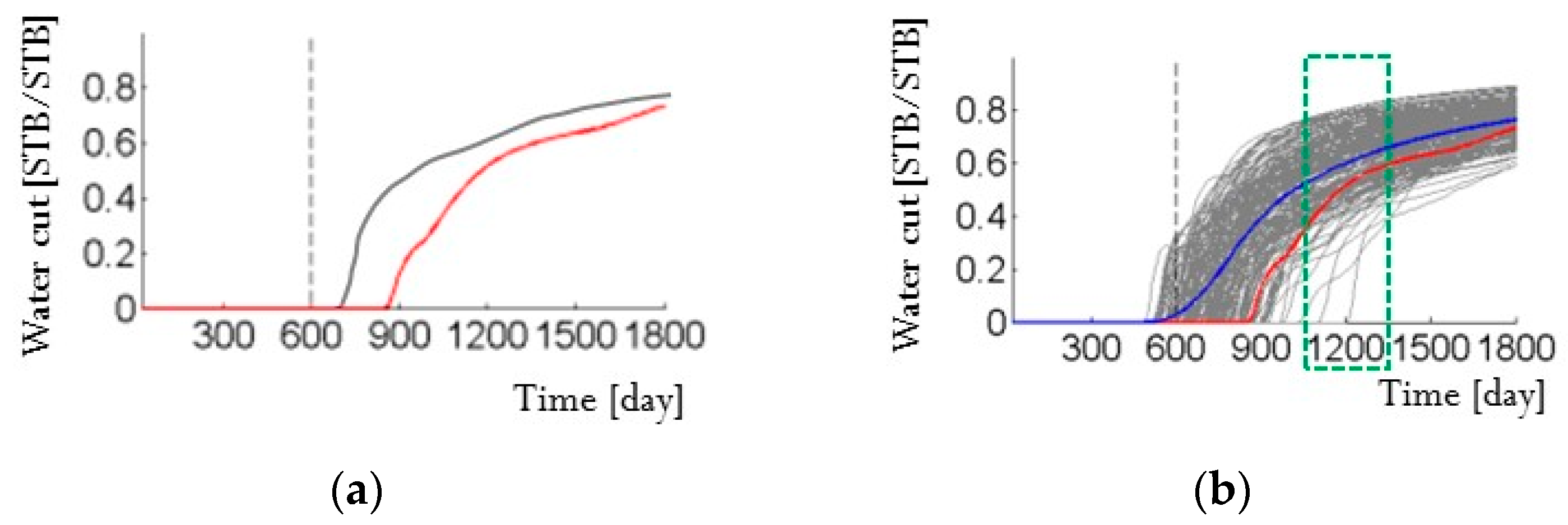
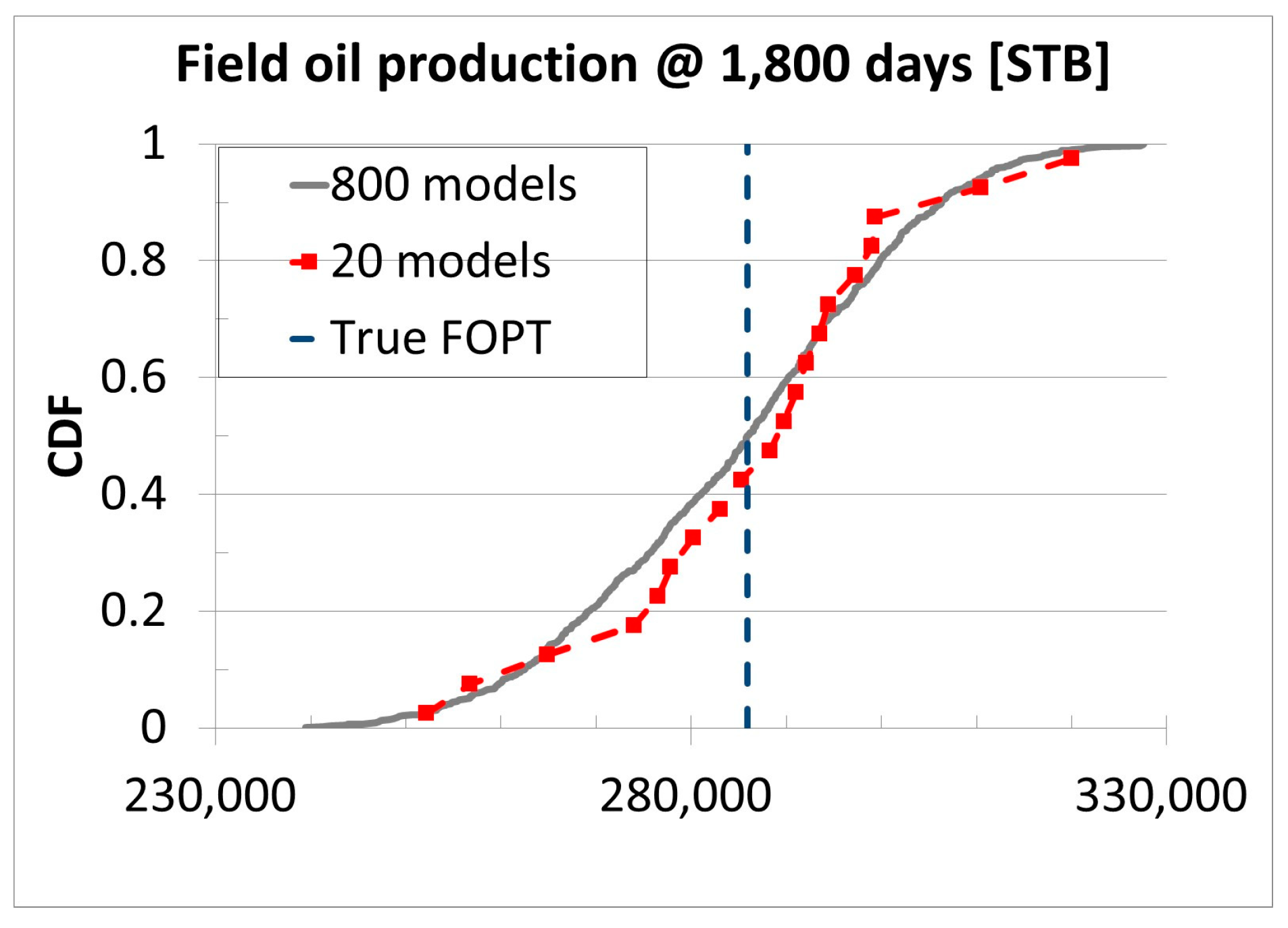
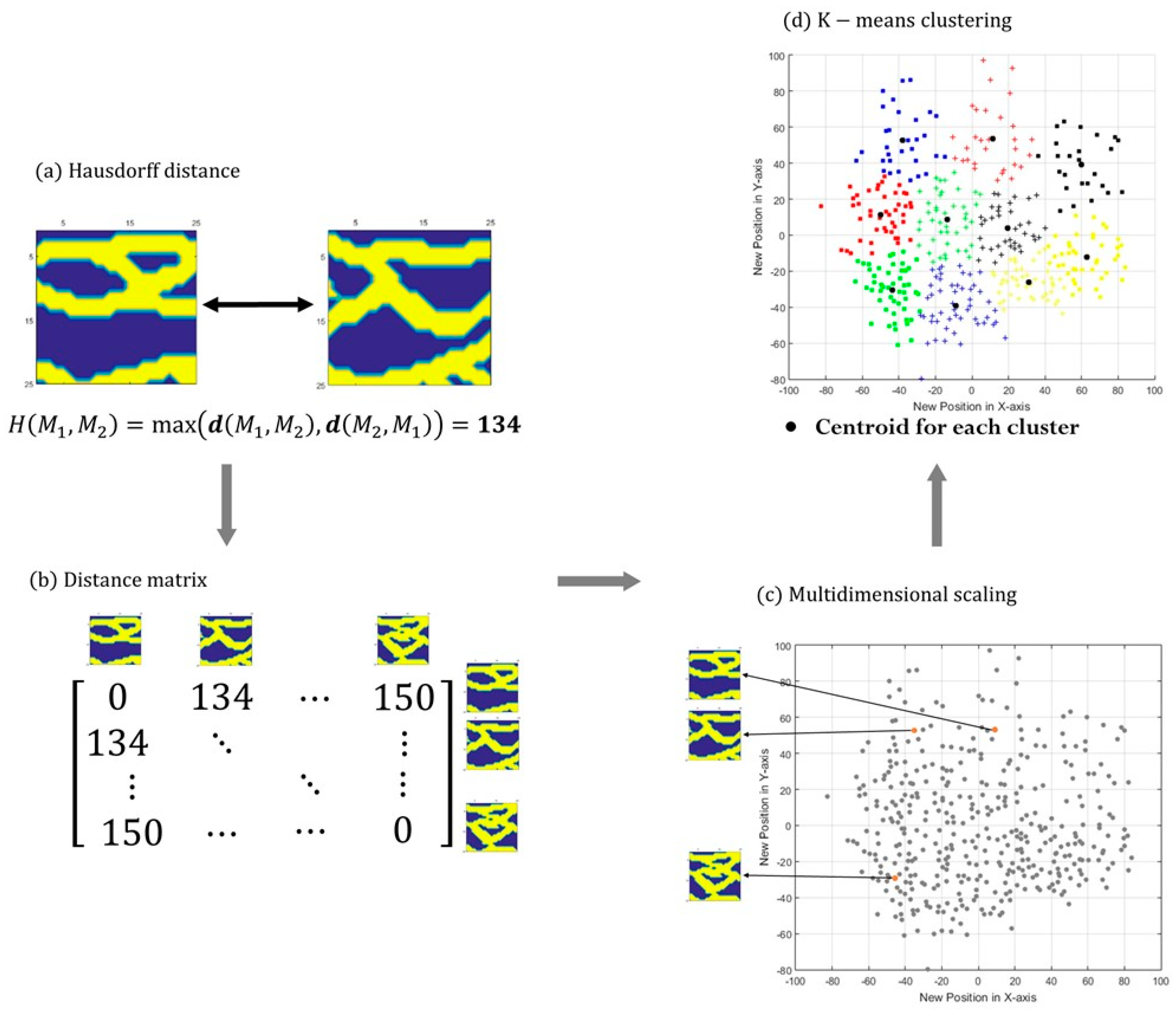
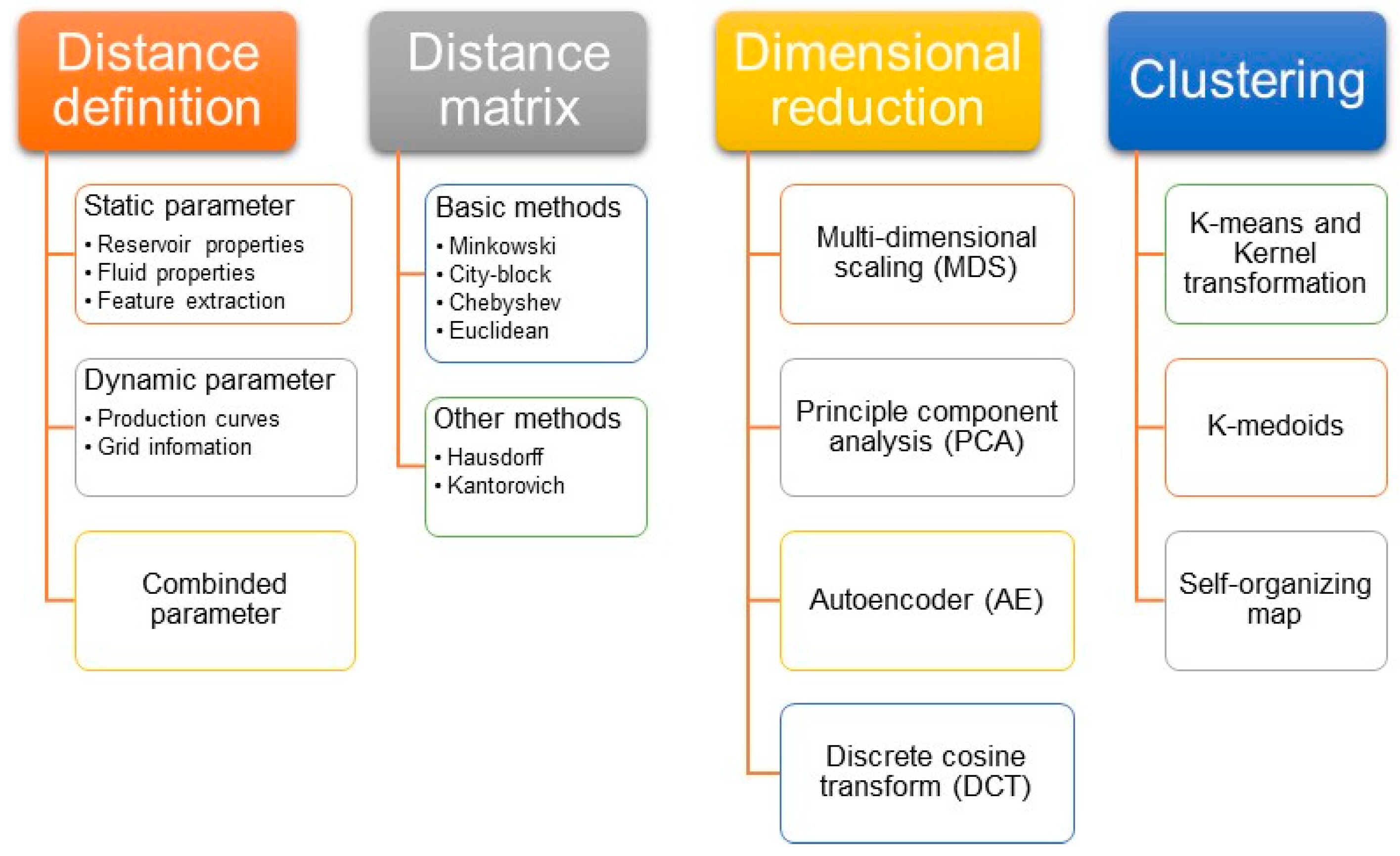
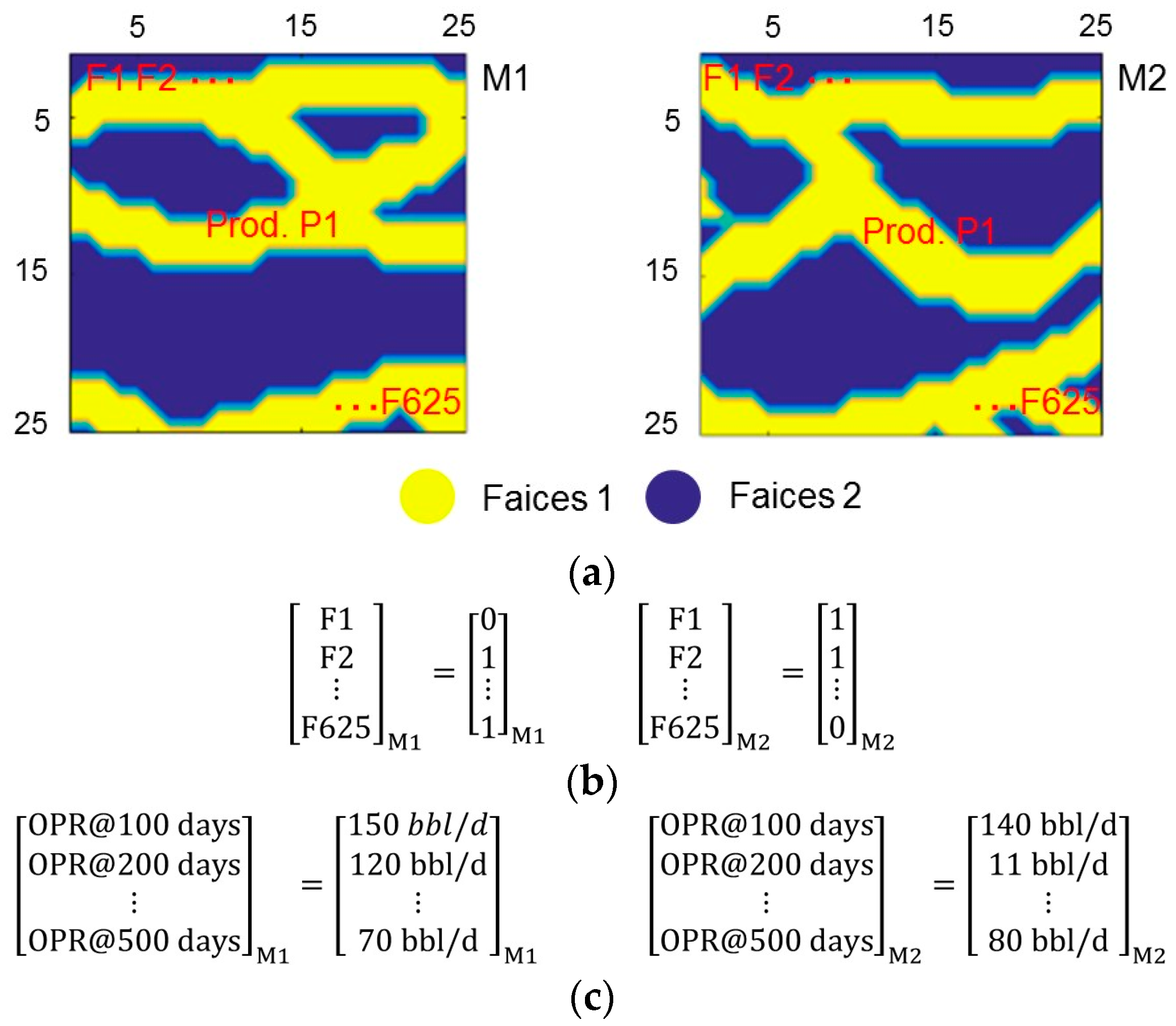
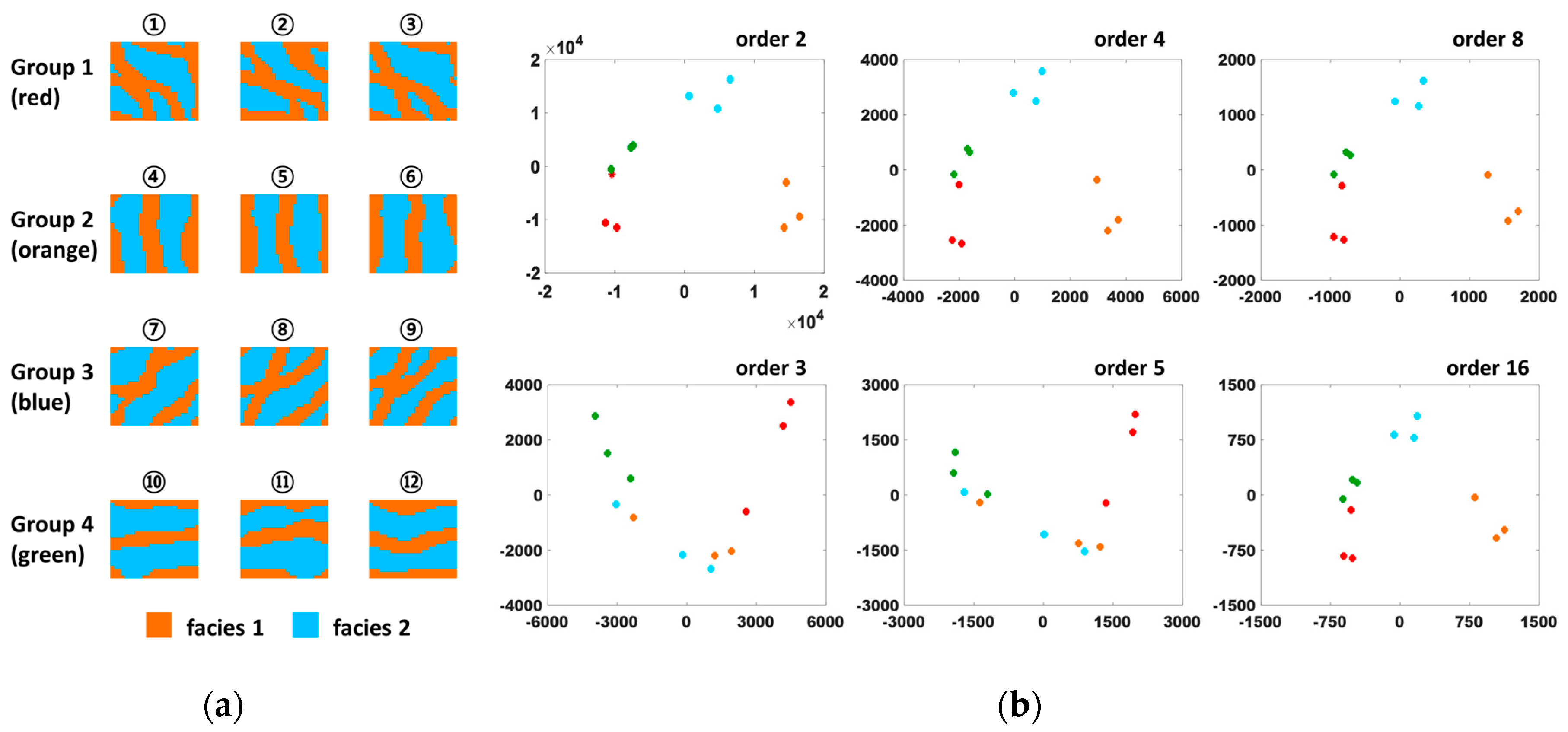
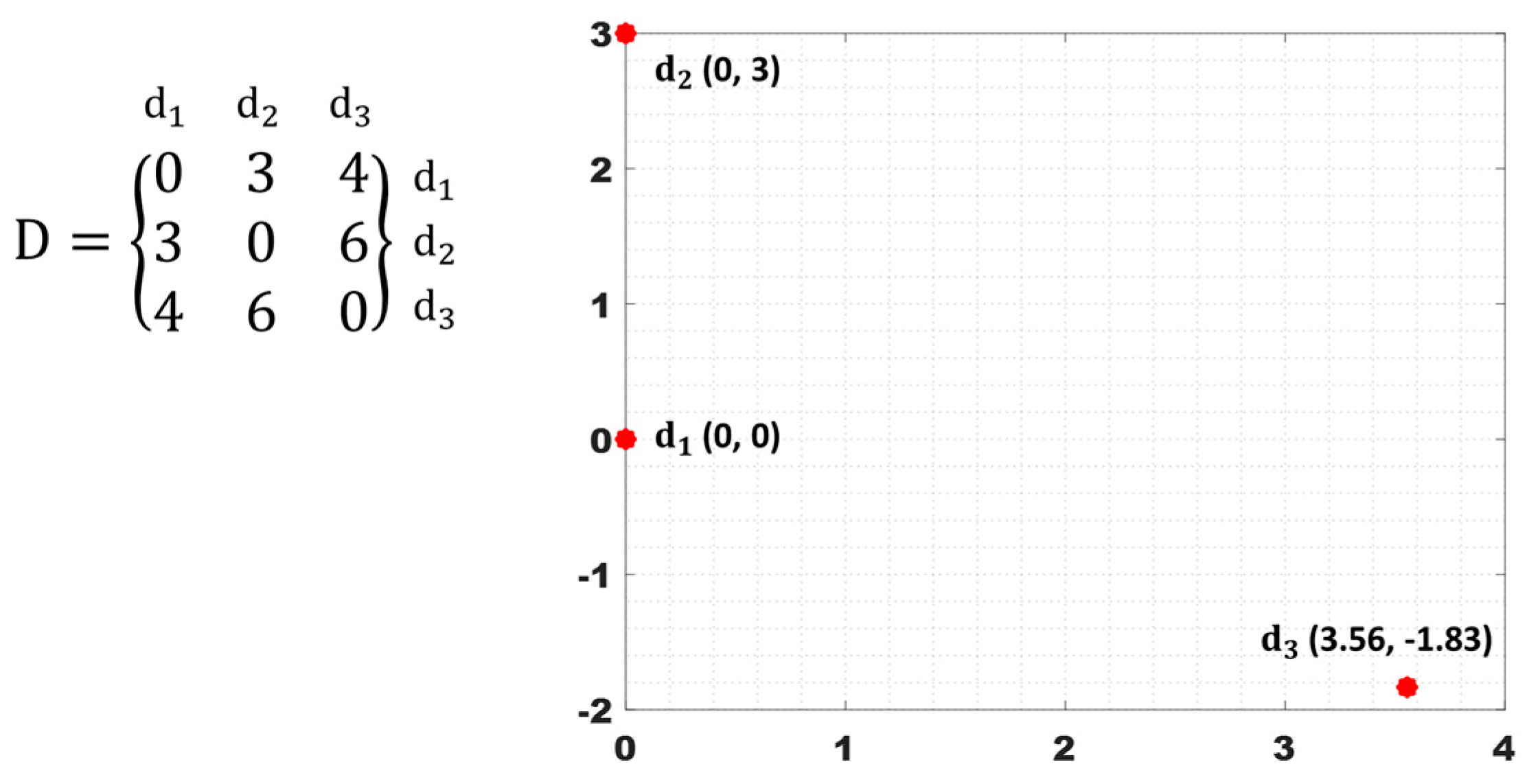
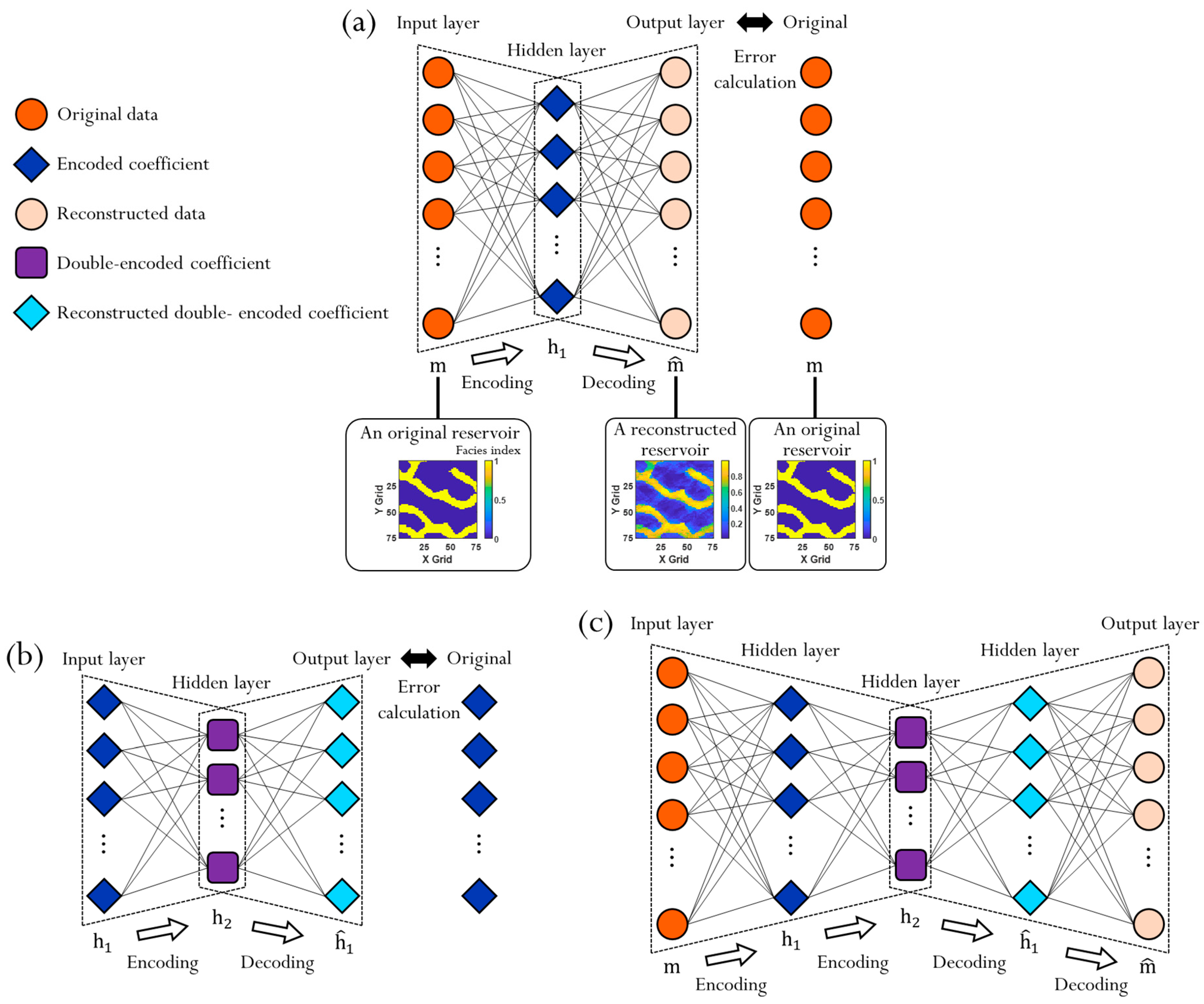
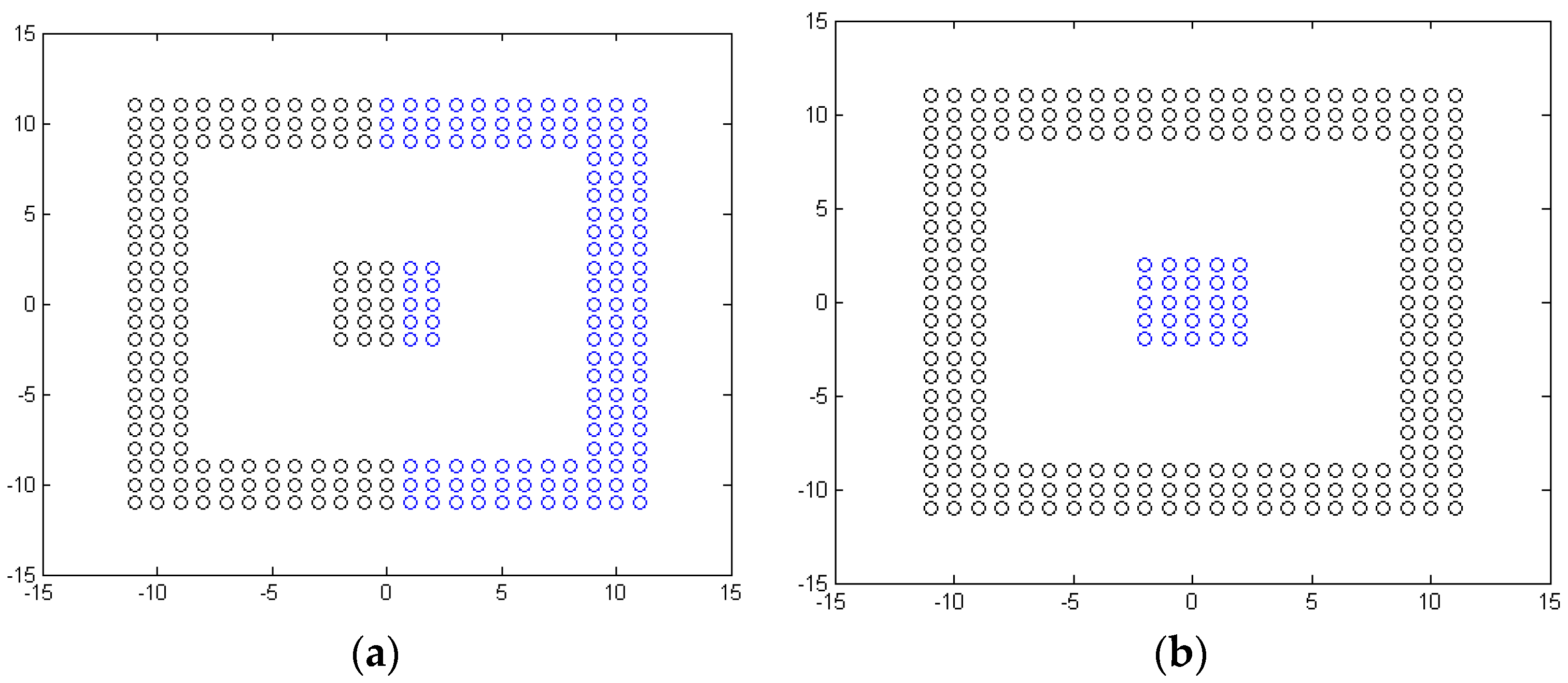
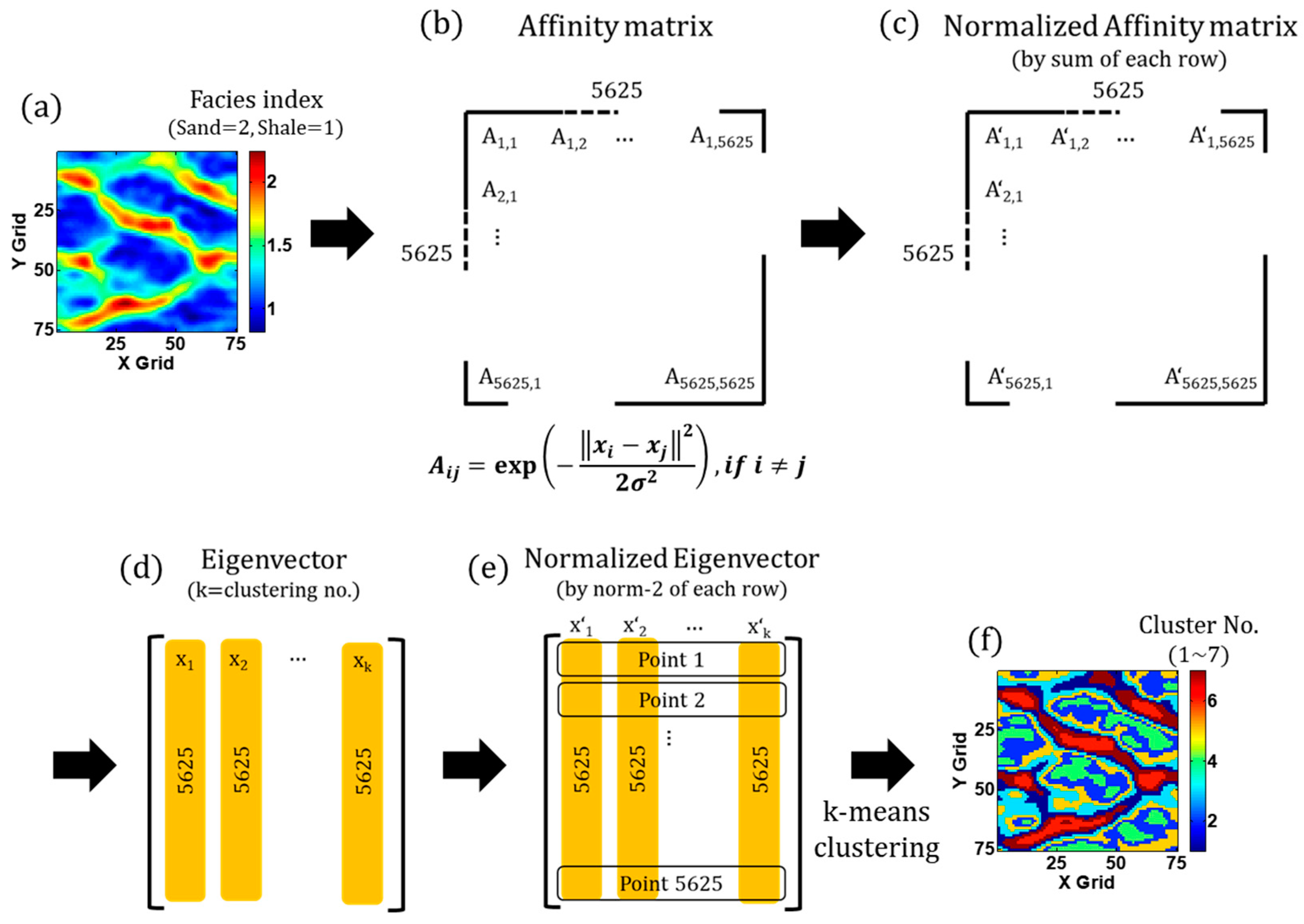
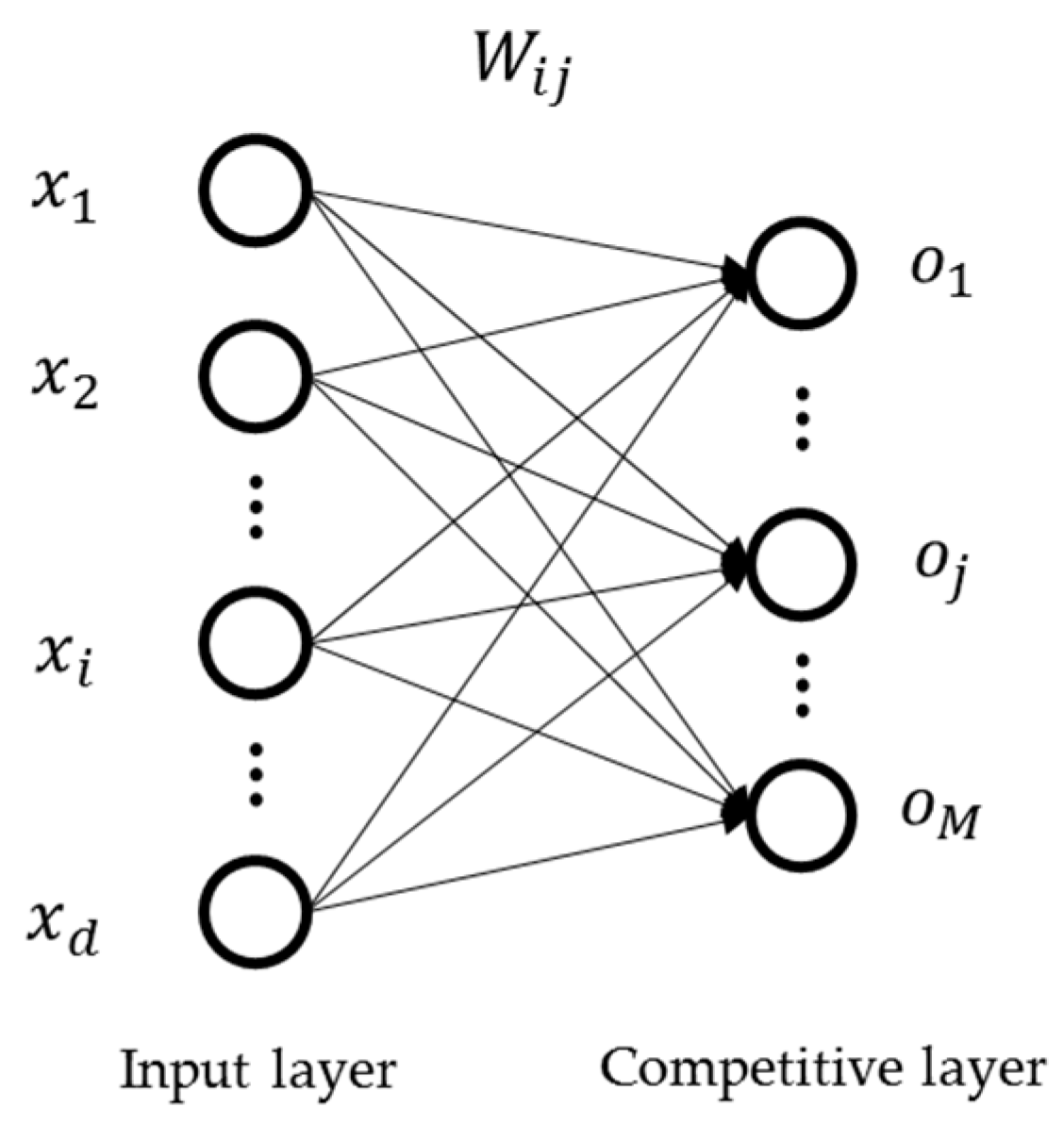

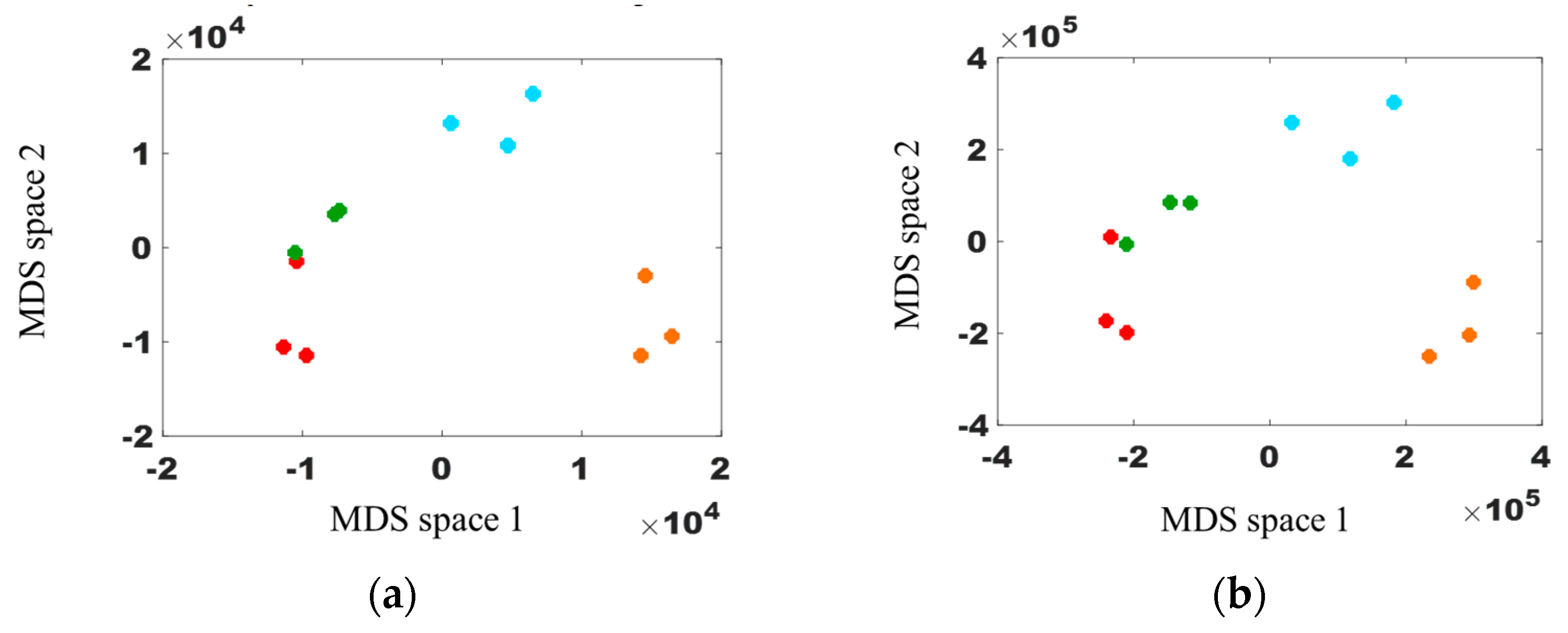
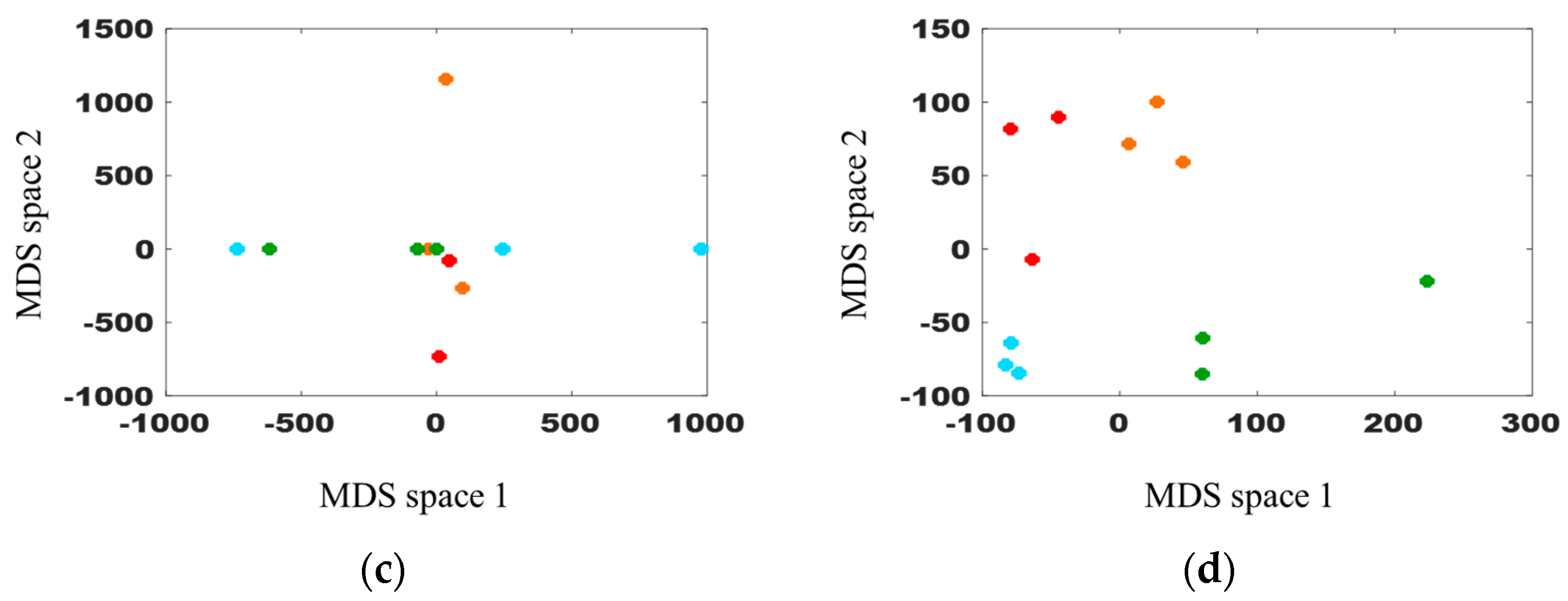
| Distance | Mathematical Form |
|---|---|
| Euclidean | |
| Minkowski (order ) | |
| City-block | |
| Chebyshev |
| Data | ||||
|---|---|---|---|---|
| Distance,() | Euclidean | 11.36 | 9.59 | 4.47 |
| Minkowski (order 4) | 9.25 | 9.03 | 3.58 | |
| City-Block | 21 | 14 | 8 | |
| Chebyshev | 9 | 9 | 3 | |
| Hausdorff | 6 | 6 | 0 | |
© 2019 by the authors. Licensee MDPI, Basel, Switzerland. This article is an open access article distributed under the terms and conditions of the Creative Commons Attribution (CC BY) license (http://creativecommons.org/licenses/by/4.0/).
Share and Cite
Kang, B.; Kim, S.; Jung, H.; Choe, J.; Lee, K. Efficient Assessment of Reservoir Uncertainty Using Distance-Based Clustering: A Review. Energies 2019, 12, 1859. https://doi.org/10.3390/en12101859
Kang B, Kim S, Jung H, Choe J, Lee K. Efficient Assessment of Reservoir Uncertainty Using Distance-Based Clustering: A Review. Energies. 2019; 12(10):1859. https://doi.org/10.3390/en12101859
Chicago/Turabian StyleKang, Byeongcheol, Sungil Kim, Hyungsik Jung, Jonggeun Choe, and Kyungbook Lee. 2019. "Efficient Assessment of Reservoir Uncertainty Using Distance-Based Clustering: A Review" Energies 12, no. 10: 1859. https://doi.org/10.3390/en12101859
APA StyleKang, B., Kim, S., Jung, H., Choe, J., & Lee, K. (2019). Efficient Assessment of Reservoir Uncertainty Using Distance-Based Clustering: A Review. Energies, 12(10), 1859. https://doi.org/10.3390/en12101859




